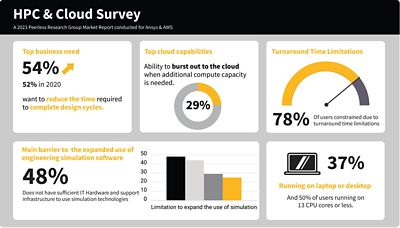-
-
Access Free Student Software
Ansys empowers the next generation of engineers
Students get free access to world-class simulation software.
-
Connect with Ansys Now!
Design your future
Connect with Ansys to explore how simulation can power your next breakthrough.
Countries & Regions
Free Trials
Products & Services
Learn
About
Back
Products & Services
Back
Learn
Ansys empowers the next generation of engineers
Students get free access to world-class simulation software.
Back
About
Design your future
Connect with Ansys to explore how simulation can power your next breakthrough.
Free Trials
ANSYS BLOG
August 17, 2023
New Survey Reveals that More Companies are Turning to the Cloud
The use of cloud-based simulations is continuing to grow after COVID-19. While findings of our 2020 research survey already indicated an accelerated adoption of cloud computing during the pandemic, our latest survey in March 2023 reveals that the use of cloud-based simulations grew from 18% to 24%; those planning to use the cloud for simulation in the next 12 months also grew from 18% to 24% compared to the 2020 survey.
The demand for greater compute resources to facilitate simulations has led to the increased adoption of cloud-based high-performance computing (HPC) within the engineering sector. Engineers using HPC are typically using more compute cores now than in 2020. Those using 13 or more cores for parallel processing increased from 44% to 50%.
While 43% of respondents were still running simulations on their laptop or desktop in 2020, that figure dropped to 37% in 2023. The data shows that engineers often use a mix of workstations, local HPC clusters, and cloud. Smaller firms tend to be more PC-dependent, with 45% running exclusively on PCs, compared to 29% of large companies. Companies of all sizes are leveraging third-party cloud resources at approximately the same level — roughly 10% using cloud along with workstations, and roughly 3% using a cloud/data center combination.

How the Cloud Improves Simulation
In terms of the most important cloud-enabled simulation capabilities, 58% of respondents noted that the ability to provide on-demand burst capabilities was extremely/very important.
Respondents also provided data on their most common design challenges, with the top three being:
- Demand to reduce the time required to complete design cycles (54%)
- Demand to produce higher quality products that are unique from competitive offerings (34%)
- Demand to create new products that address market opportunities (28%)
Effects of Large Models and Long Queues
Cloud users are running lengthy simulations and often queuing for several hours to tap into shared compute and software resources. Companies are running larger analyses across more physics and doing so more frequently. Cloud-based simulation resources can help these companies to run these analyses faster in a more flexible manner.
These lengthy runtimes and long queues are having a direct impact on simulation usage and modeling quality. As per the survey findings, 38% of participants stated that they limit the size and level of detail in their simulation models due to hardware limitations. Additionally, 28% of respondents noted that extended computational wait times diminish the practicality of using more intricate models, a notable increase from the 19% reported in 2020.
When it comes to reducing the time constraints on modeling and fidelity, respondents believe that a mixed approach that leveraged new on-premises hardware and cloud-based solutions could improve their analysis activities. Roughly half of respondents thought that replacing current hardware, upgrading existing hardware, or adding HPC licenses to run simulations at higher core counts would be an effective approach.
When evaluating barriers to acquiring new HPC hardware/infrastructure, 71% of respondents cited evidence of the benefits to simulation workloads as extremely or very important, followed by quantifying the business value and ROI (68%). Other important factors in making the investment decision included being able to obtain help to specify ideal hardware configurations (59%), having the resources to manage more complex hardware configurations, overcoming the operational time/risk associated with new hardware deployments, and understanding how third-party hardware (i.e., cloud solutions) can satisfy the companies’ needs (all tied at 55%).
Cloud Computing Continues to Expand
Cloud-enabled simulation is poised to continue expanding because of a variety of factors. As models become more complex and engineers are pressured to create new and better iterations faster, environments that rely exclusively on workstations and local data centers will present time and resource constraints that can stifle innovation.
At Ansys, we understand that cloud deployment strategies are a key part of the expanded use of engineering simulation in product development workflows. Cloud computing can help engineers access HPC capacity to enable rapid iteration and design space exploration, as well as detailed simulation and analysis of complex, high-fidelity models, secure data access and collaboration, and improved productivity. As always, we will continue to enhance the capabilities of our software for use on cloud-based platforms, and industry leading cloud service providers like Amazon Web Services (AWS), to overcome any challenges to growth in this field.
If you want to know more, us for a dedicated online event.
Interested in learning more about Ansys Gateway powered by AWS? Contact us!